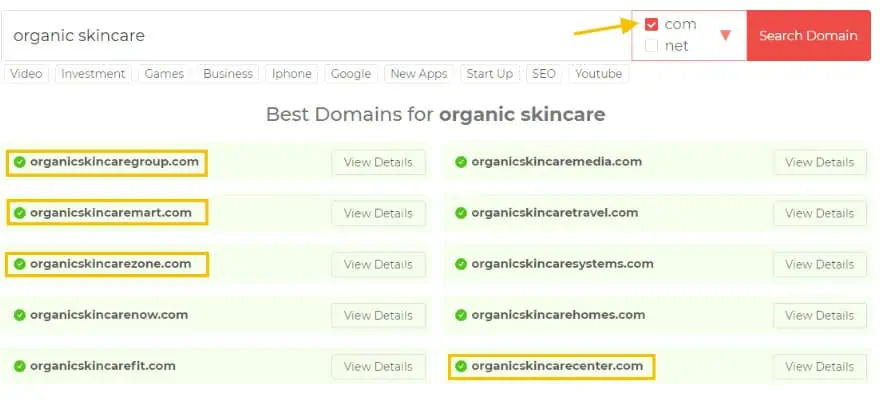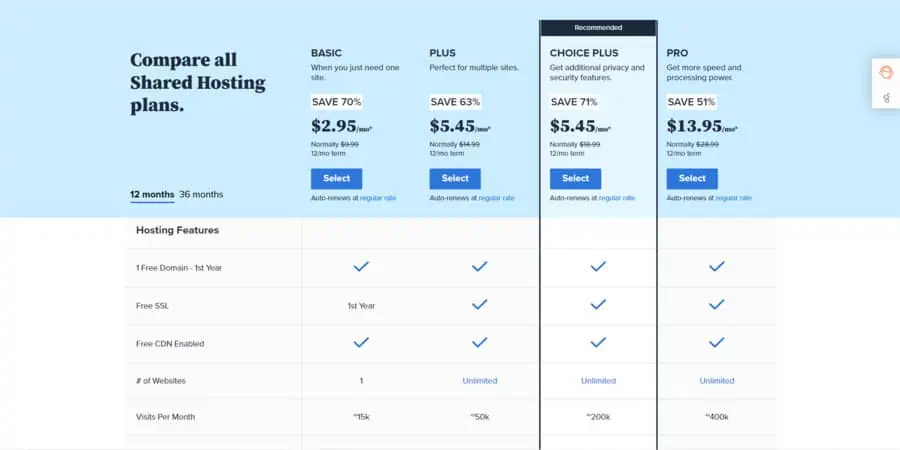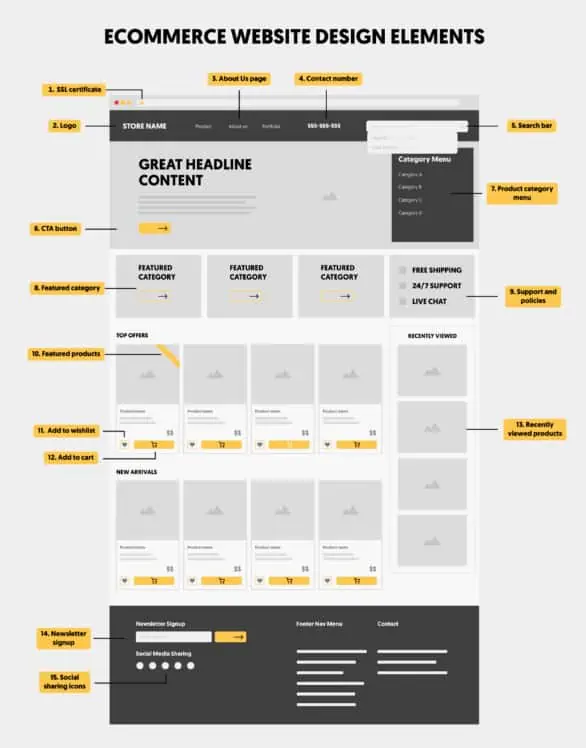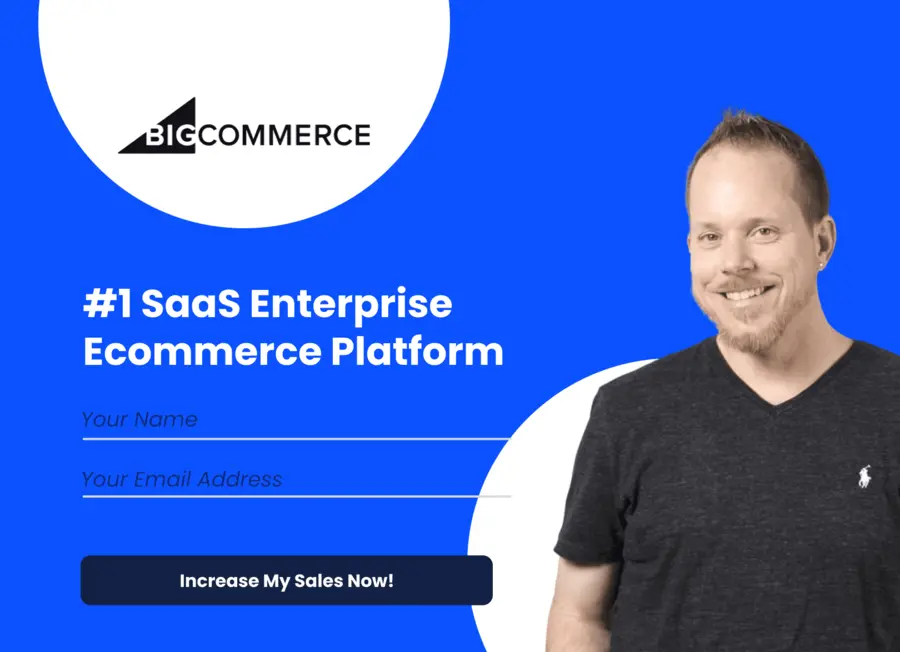Learning how to build an ecommerce website isn’t as difficult as it was a decade ago. There are plenty of improvements and tools that have been developed over the last few years. Even beginners can create a store on these platforms. And no need for any coding experience!
If you follow these 9 easy steps I’ve laid out for you in this article, you’ll know how to build an ecommerce website in no time.
Why Should You Build an Ecommerce Website?
Before I show you how to start building an ecommerce website, let’s understand why it matters.
Building an ecommerce website can help you reach new markets and continue selling if your brick-and-mortar store has to be closed due to unforeseen circumstances.
With an eCommerce website, you can sell your products to consumers around the world. Your business sales will no longer be limited to local consumers.
Here are 3 Reasons Why You Need an Ecommerce Website:
1. Customers Prefer Shopping Online
The number of American customers who shop online is projected to be 291.2 million by the end of 2025. That’s nearly 80% of the population.
Even pre-pandemic statistics show that there was a preference for online shopping.

Certain industries like home entertainment and consumer electronics already had more than half of customers purchase these products online before the pandemic with more growth expected.
The most interesting of all is the expected post-Covid-19 projections that show that grocery shopping online doubled during the pandemic, but that it will see more growth post-pandemic.
As more people work longer hours due to economic, social, or familial circumstances, more customers are willing to use online shopping to save time.
2. Smaller Financial Risk
Traditional retail shops have a much higher financial risk, due to the amount of money it takes to not only open one but keep it running.
The truth is that 20% of retail businesses will fail within a year and, after five years, almost half will close.
Starting an ecommerce website can cost anywhere between $10 000 to $20 000. This will depend on licensing fees, whether you will dropship or sell directly to your customers as well as having an in-house team or not.
This is still much less than the estimated $50 000 – $100 000 to start a small retail shop.
3. Maximizing your options
If you’re already the owner of a retail shop, creating an ecommerce website is an excellent way to expand your physical shop’s presence, without spending excessive amounts of money.
Ecommerce websites allow you to quickly inform any potential customers of new promotions and discounts without paying heavily for marketing or pointing it out inside of a shop.
What to Consider When Creating an Ecommerce Site
Creating an ecommerce website is easy, but creating an effective ecommerce website that not only attracts customers but actually converts them, is a whole other thing.
That means getting everything right from the beginning is important so that your website can quickly start selling products to earn back your initial investment.
Here are 5 things to consider when creating an ecommerce site:
- Make sure that your website is optimized for all possible devices.
- Make sure your contact information is easily found as well as customer service.
- Have as many payment options as possible for customers.
- Make sure your website supports SSL for information encryption.
- Make sure your website is readable, easy to navigate, and looks great.
Your Step-by-Step Guide to Build an Ecommerce Website
Building an ecommerce website is simpler than you may imagine, especially when you’ve got solutions like WordPress and BigCommerce.
These solutions can do most of the work for you and help you build an eCommerce site without any coding knowledge.
However, you’ll still need to make many important decisions to plan, create, launch, and promote your eCommerce website.
Let me help you get started.
Step 1: Conduct Market Research to Find Your Niche
First things first when building an ecommerce website, you need to identify what type of products you would like to sell and if there is a potential market demand for those products.
It is also important to consider your interests and professional background while choosing your niche. Building a business requires a lot of hard work and persistence. If you are selling something that you are interested in, it will help you stay motivated.
When you pick a product for your eCommerce business, you should ensure that:
- You have professional experience in related fields and are familiar with the industry.
- The product solves a problem for customers.
- People will be willing to pay for it.
- Your product idea aligns with the latest trends and demands in your industry.
- Your product has a low investment cost and a good profit margin.
- You have something unique to offer than your potential competitors.
Pro tip: Picking the right products to sell on your eCommerce website is essential to your success. So, take your time deciding which products to sell and to whom.
Step 2: Get a Domain Name
One of the initial steps to taking your business online is to pick your business and domain name.
Here are a few tips for selecting a domain name:
- Make sure that it is closely connected to what you sell.
- Include a keyword or a key phrase that helps customers know what you sell up-front.
- Keep it short.
- It should be easy to type, pronounce, and remember.
- Avoid legal and copyright issues.
- Buy a “.com” domain name as it is the most popular TLD (top-level domain). If it’s not available, you can consider buying “.store” or “.online” domain names.
How do you get a domain name?
Once you have a few ideas for your domain name, you can purchase it using a domain registrar.
All you need to do is to visit the domain registrar, search for your selected name, and see if the domain name is available.
A domain registrar will register your domain name under the name of your company, meaning no other company can use the same domain name as you.
There are plenty of companies where you can buy domain names like:
- Mailchimp.com
- GoDaddy.com
- NameSilo.com
- Name.com
- Dreamhost
For example:
If you want to run an ecommerce business that sells organic beauty products, you can look for the “organicskincareproducts.com” domain name.
You’ll realize that this domain name is already taken.

However, you can buy “.online” and “.store” domain names with the same business name, as suggested by Bluehost or other domain registrars.

Or, you can look for similar alternatives available with the “.com” extension using domain name generators like DomainWheel. Choose any of the suggested names that are relevant to what you want to sell.

Step 3: Buy Web Hosting
The next step to building an ecommerce website is to get a web hosting plan.
Web hosting is essentially like renting or buying a house. Instead of it being a physical space, you’re purchasing or renting a piece of online space on the World Wide Web.
How to choose a hosting provider
Hosting a simple blog or website usually doesn’t require a bunch of different website-building tools, but it is important to invest in a great host when it comes to an ecommerce store.
When deciding which host to choose, keep in mind:
- How many initial visitors your site will get, as well as how large it will grow in the next year or two. This should enable you to choose a host that can accommodate the amount of traffic your website will get.
- Greater uptime is important. Uptime is essentially a measure of a system’s reliability. It’s the normal period when the website is functioning. Find out how much downtime your website might expect, especially during busy times like month’s end or holidays.
Bluehost and HostGator are two of the most trusted web hosting providers in the market.
When you’re just starting out, it’s considered best to buy Bluehost’s Basic plan, which is also their most popular plan.
However, when hosting an ecommerce store, I recommend buying Bluehost’s Pro plan which includes options to accept WooCommerce payments, add products, and use pricing templates.

Also, check out: 7 Bluehost Alternatives for Your Business Website
Step 4: Choose Your Ecommerce Platform
There are many options when it comes to deciding on your eCommerce platform.
You can either use a website builder, an online store builder, or a dedicated eCommerce platform to set up and run a successful online store.
Let’s discuss some of these options to build your eCommerce store.
Build an eCommerce Website on WordPress
You can easily build your ecommerce website on WordPress. Hosting providers like Bluehost offer one-click WordPress installation to make it easier for you.
If you’re especially concerned about SEO, you can find plenty of excellent ecommerce platforms for SEO online.
If you have a WordPress website or blog already, you can also turn your existing WordPress site into an online store.
You can install eCommerce plugins such as WooCommerce and BigCommerce to add eCommerce functionality to your WordPress website.
This includes adding product pages, secure payment methods, shopping cart and checkout options, shipping options, and more.
It’s simple.
Head to Plugins > Add New > search for “WooCommerce” or “BigCommerce” and then install the plugin.

Here’s a list of some of the best WooCommerce plugins for your eCommerce website.
With these plugins, you’ll be able to:
- Choose from enticing themes to finalize your online store’s design.
- Showcase physical and digital products along with their variations, pricing, etc.
- Leverage WordPress’ SEO advantage to rank well in search engines
- Accept secure payments from 100+ payment gateways like Stripe, PayPal, etc.
- Configure shipping options with WooCommerce Shipping solution.
- Automate sales tax calculations.
- Reach your target audience more efficiently with HubSpot, Facebook, and Mailchimp integrations.
Check out 15+ other website builders that you can use to build your ecommerce site.
Build Your Ecommerce Website with Dedicated Ecommerce Platforms
You can also build your online store using dedicated eCommerce platforms such as BigCommerce. It is an intuitive SaaS solution that offers everything you need to build an ecommerce website and sell online.
With BigCommerce, you’ll get:
- Storefront design options such as fully customizable and responsive themes, Page Builder with a visual editor, checkout customization, mobile optimization, etc.
- 70+ discounts and promotions options
- Custom product recommendations
- Digital payment options like Apple Pay, Amazon Pay, PayPal, etc.
- Online marketplace integrations to allow you to sell products on Amazon, eBay, etc.
- One-page checkout feature
- Inventory management solution
- Social channel integrations with Facebook, Instagram, and Pinterest to encourage social commerce
- Multi-currency payment processing
- Global content delivery network (CDN) to ensure your site loads quickly
- Easy-to-use shipping solution
You can also use Shopify, 3dcart, and other eCommerce platforms to build your eCommerce website.
Most online store builders and eCommerce website builders offer easy drag-and-drop editors to help you build your site without any coding knowledge.
However, you can still consider hiring a professional web developer to save time and design an impressive eCommerce store.
Step 5: Plan Your Ecommerce Website Structure and Elements
Regardless of the eCommerce platform you choose, you’ll need to plan the structure of your online store and figure out what functionalities you want to add.
Your eCommerce website should have the following elements:
- SSL certificate
- Logo
- Navigation menu and search bar
- “About Us” page that tells your brand’s story
- Product category pages to make it easier for shoppers to find the products they want to buy
- Product pages with product photos, product descriptions, pricing details, etc
- Wish list functionality to help shoppers save products that they would like to buy later
- Customer service pages such as Returns and Refunds Policy, Shipping Policy, and Privacy Policy pages
- Secure checkout process and payment gateway options
- Blog content that you’ll update regularly with articles related to ecommerce to get more exposure for your brand and products
To help you understand the essential eCommerce website design elements, check out the infographic below.

Also, check out my post on the 6 components of eCommerce website design.
Step 6: Pick a Theme for Your Ecommerce Website
Pick a theme that aligns with your vision for your ecommerce website. It will act as the foundation for your website’s design and functionality.
When picking a theme, you should consider the following parameters:
- Does the theme offer user-friendly navigation menu options?
- Does your homepage design align with the aesthetics of your brand?
- How many built-in eCommerce features and customization options does the theme offer?
- Is the theme compatible with standard eCommerce plugins?
- Does the theme offer cross-selling and upselling capabilities for product pages?
The goal of your eCommerce site should be to encourage users to shop online.
Too many elements or a cluttered design can distract shoppers. So, you should choose an eCommerce theme with a modern and clean design.
For example:
100% PURE, an organic and natural beauty products eCommerce brand, has a minimalistic and clean website design that makes navigation a breeze for their new customers.

You can see products with top reviews and customers' favorite products on the homepage itself. The hello bar highlights that they offer free shipping. The product images are of high quality and drive attention.
When starting out, it is best to start with a free theme. Once your eCommerce business starts making money, you can switch to a paid theme with greater functionality.
Here are a few ecommerce themes that can be a good starting point for building your online store:
- Haat WooCommerce theme
- Cornerstone BigCommerce theme
- Vault BigCommerce theme
- SuitUP Shopify theme
- Divi WordPress theme
You can check out 25 more ecommerce template options here.
Step 7: Add Products to Your Ecommerce Website
The most daunting step of building an online store is to create product pages.
Your product pages should include:
- Product name
- Product description with keywords
- Pricing details
- Product variations and customization options
- Compelling CTAs
- Shipping & return policies
- Expected delivery date
Your product page should provide all of the information that a potential buyer would need to know including its basic details, durability, use cases, and benefits.
Include high-quality product photos that highlight the key features of your product from different angles. You can also use 360° photos, a zoom-in feature, and in-context images and videos to attract new customers.
Home decor and furnishings brand, Pottery Barn, creatively uses in-context product images to encourage customers to buy their items.
I mean – Who wouldn’t like to recreate this Christmas look in their living room?

Don’t forget to optimize your product pages as well to boost conversions and drive more sales and revenue.
Step 8: Set Up Payment Methods and Shipping Process
While website design, easy navigation, and impressive photos can encourage users to buy a product, you need to offer the right payment method to close the deal.
When choosing payment integrations, you should:
- Analyze whether the payment gateway is safe.
- Look at customer reviews to see if people had problems making secure payments using that payment solution.
- Keep the payment processing and transaction fees in mind.
- Check if you’ll be able to accept payments from international customers.
- Make sure that it is PCI compliant to avoid fines, lawsuits, and losing customers’ trust.
Along with payment integrations, shipping is an integral part of running an eCommerce business. You should:
- Determine your shipping policy. Will you offer free shipping or do shipping at a variable rate based on the buyer’s location?
- Choose your shipping partner.
- Consider whether or not you will ship products to international customers.
- Decide on which shipping software you’ll use for your new eCommerce website.
Step 9: Launch and Promote Your Online Store to Start Selling
Once you’ve put everything together, it’s time to launch your ecommerce business website to sell products online.
However, setting up your online store is not enough. To turn your website into a successful online business, you need to come up with a robust marketing strategy.
Understand who your target audience is, what matters to them, and how you can encourage them to shop online from your store.
For this, you can include a number of different strategies in your marketing efforts such as:
- Search engine optimization (SEO) to rank your online business website in search results
- Email marketing to reach your target audience with offers, discounts, and personalized product recommendations
- Social media marketing to build an online presence for your ecommerce business and gain more traction
- Influencer marketing to spread the word about your ecommerce business quickly and generate more sales
- Affiliate marketing to drive referral sales in a cost-effective manner
While promoting your ecommerce business, you should follow the latest ecommerce marketing trends to generate quick results.
If you need help growing your online store sales, feel free to reach out to me anytime. Just fill out the form on my contact page to get started.
FAQs
1. How much does it cost to build an ecommerce website from scratch?
With so many easy-to-use website builders out there, you can build an ecommerce website without hiring any web designer and developer.
However, you’ll still need to pay for the domain name and web hosting, which can cost you between $50-$100 per year.
If you want to hire a professional to design a custom ecommerce website for you, then it can cost over $10,000.
The actual cost will depend on the ecommerce platform or online store builder you choose and how complex the website will be.
2. How do I create an ecommerce website?
To create an ecommerce website, you should buy a domain name and web hosting, choose an ecommerce platform, and plan the site structure.
Accordingly, pick a theme, create essential pages, add products, and start selling online.
You can look at the online stores or ecommerce websites of your competitors to get inspiration.
3. What is the cheapest way to build an ecommerce website?
The cheapest way to build an ecommerce website is to:
–Choose the best ecommerce website builder or online store builder to build your website. WordPress with WooCommerce, BigCommerce, and Shopify are a few eCommerce website builders that can help.
– Pick a free ecommerce theme that offers all essential built-in eCommerce solutions.
– Use drag-and-drop editors to create your website on your own. This will help you save the cost of hiring a professional developer.
– Focus on product photography to attract customers.
– Leverage email marketing, content marketing, SEO, affiliate marketing, and other channels to boost online shopping on your website.
– Improve your website’s functionality and design over time with the profits from your eCommerce sales.
Start with minimal investment and grow your ecommerce brand over time.
Ready to Set Up and Run Your Own Ecommerce Website?
Building an ecommerce website has become easier because of powerful eCommerce platforms and online store builders with built-in ecommerce features.
You just need to make the right choice for your business model, website structure, payment processing, and shipping software, sales tools, marketing strategy, and more. Most importantly, choose the right ecommerce platform to build your online store.
Do you have questions about building your ecommerce website and making money from it? Reach out to my team of experts to take your retail business online and market it efficiently.



Related Articles
11 Best Ecommerce Platforms to Set Up an Online Store
Top B2B Ecommerce Platforms for 2024
How to Build an Ecommerce Website in 9 Easy Steps
11 Best Ecommerce Platforms for Small Businesses in 2024
The World’s Top Ecommerce Companies (2024 List)
25 Best Ecommerce Tools to Grow Your Business in 2024